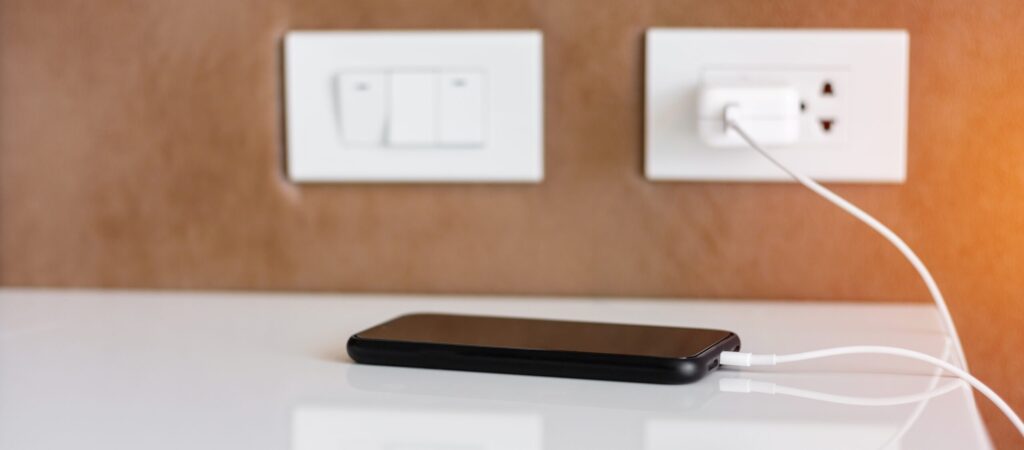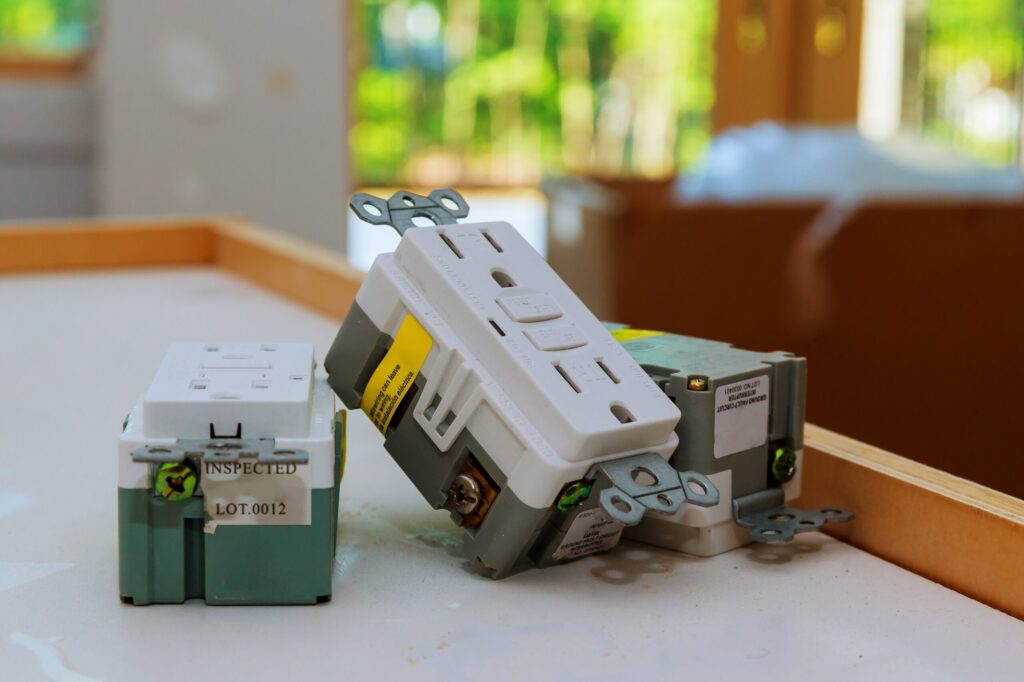The Difference Between GFCI and Regular Outlets
Take a quick walk through your home and you’ll likely notice two different types of electrical outlets installed on your walls. The most common is the standard duplex outlet, a familiar and simple interface that has powered our lives for decades. But in certain areas, like your kitchen and bathrooms, you’ll find a different kind of outlet; one that has two small, distinct buttons nestled between its receptacles, usually labeled “Test” and “Reset.”
Most homeowners recognize that these two types of outlets are different, but many don’t fully understand the critical and life-saving distinction between them. The presence of those little buttons signifies a massive leap in electrical safety technology. Understanding the fundamental difference between a standard outlet and a GFCI outlet is a crucial part of responsible homeownership. It’s the difference between a simple gateway to power and a smart, active safety device that is constantly working to protect you and your family from a severe electric shock.
The Standard Outlet
A standard electrical outlet is designed to perform one straightforward and essential job: to provide a consistent and reliable 120-volt path for electricity to flow to an appliance or device. It has three openings: a smaller “hot” slot that delivers the electrical current, a larger “neutral” slot that completes the circuit by returning the current, and a round “ground” opening that provides a safety path in case of a fault.

The only safety device that a standard outlet relies on is the circuit breaker located back in your home’s main electrical panel. A circuit breaker’s job is to protect the wiring inside your walls from overheating and causing a fire. It does this by tripping and shutting off the power if the circuit is overloaded with too many devices or if a short circuit occurs.
It is critical to understand, however, that a circuit breaker is not designed to protect people from electrocution. The amount of electrical current needed to trip a standard 15 or 20-amp breaker is many times greater than the tiny amount of current that can cause a fatal electric shock. A standard outlet will happily continue to deliver a dangerous level of electricity in a situation that could harm a person, as long as the total current doesn’t threaten the house wiring. This is where the specialized, life-saving role of the GFCI comes in.
How a GFCI Outlet Works
A GFCI, or Ground Fault Circuit Interrupter, is a remarkable piece of technology. It is essentially a smart, fast-acting safety device that is built directly into an outlet. Its one and only job is to do what a standard circuit breaker cannot: protect people from a dangerous or fatal electric shock.
The best way to understand how a GFCI works is to think of it as a highly sensitive and diligent accountant for your electricity. It has a tiny internal sensor that is constantly monitoring the amount of electrical current flowing out to a device on the hot wire and the amount of current returning to the outlet on the neutral wire. In a normal, safe electrical circuit, these two amounts should be perfectly and exactly equal.
A “ground fault” is a dangerous situation where some of the electricity finds an unintended and alternative path to the ground. This alternative path could be through a puddle of water, a frayed appliance cord touching a metal sink, or, in the most critical scenario, through a person’s body. The GFCI’s internal accountant instantly detects that some of the current is missing; that the electrical flow is unbalanced. If it detects a mismatch of as little as 4 or 5 milliamps, it assumes that a dangerous ground fault is occurring. Within an incredible 1/40th of a second, long before a dangerous amount of electricity can affect your heartbeat, it trips and shuts off the power to the outlet, potentially saving a life.
Where Are GFCI Outlets Required?
The National Electrical Code (NEC), which sets the standard for safe electrical installations across the country, has a clear and simple guiding principle for where GFCI protection is required: anywhere that electricity is likely to come into contact with water. Water is an excellent conductor of electricity, and its presence dramatically increases the risk of a ground fault and a fatal electric shock. Because of this, the code mandates that GFCI outlets be installed in specific locations in all modern homes.
For any home built in recent years in Greenville, you are required by code to have GFCI protection in all of your bathrooms and in your kitchen for all outlets that serve the countertops. The code also requires them for any outlets in your garage, in unfinished basements and crawl spaces, and for all outdoor receptacles on the exterior of your home. They are also required in laundry areas and for any outlet located near a wet bar or utility sink.
It is important to note that these code requirements have been expanded over the years as our understanding of electrical safety has grown. If you live in an older home, it may not have GFCI protection in all of these critical areas. While your home may have been “up to code” when it was built, it does not meet the modern standard for electrical safety. Upgrading your outlets in these key locations is one of the most important safety improvements you can make for your home.
How One GFCI Can Protect Many Outlets
As you inspect your home, you may notice a situation where one outlet in a bathroom has the “Test” and “Reset” buttons, but another outlet in the same room is a standard-looking receptacle. It is a common misconception that this standard outlet is unprotected. In many cases, it is protected by its upstream GFCI neighbor.

A licensed electrician can wire a GFCI outlet in such a way that it provides ground fault protection to all the other standard outlets that are connected “downstream” from it on the same circuit. This is a safe and cost-effective way to provide protection to multiple locations without having to install a more expensive GFCI outlet in every single spot. The first outlet in the circuit acts as the primary safety device for all the others.
You can easily test for this. Find the GFCI outlet in the room and plug a small lamp into a nearby standard outlet. Now, press the “Test” button on the GFCI outlet. The GFCI should click, and the lamp plugged into the standard outlet should go out. If it does, that outlet is safely protected. If it does not, the outlet is unprotected and should be upgraded. This is also why, if an outlet in your kitchen or garage suddenly stops working, the first thing you should do is look for a tripped GFCI outlet nearby and press its “Reset” button.
Interested in having more GFCI outlet installed? Click here to learn more.
The Importance of Regular Testing
A GFCI is a complex electronic device with sensitive internal components, and like any such device, it can wear out or fail over time. It is not a “set it and forget it” component. To ensure it is always ready to protect you and your family, it is absolutely essential that you test your GFCI outlets on a regular basis.
The testing process is simple and takes only a few seconds. First, plug a small device that you can see, like a nightlight or a lamp, into the GFCI outlet and make sure it turns on. Next, firmly press the “Test” button. You should hear a distinct click, the lamp should immediately go out, and the “Reset” button should pop out. This confirms that the trip mechanism is working correctly. Finally, press the “Reset” button. The lamp should come back on, indicating that the outlet is ready to be used again.
It is recommended that you perform this simple test on every GFCI outlet in your home once a month. If you ever encounter a GFCI that fails to trip when you press the “Test” button, or if you are unable to restore power to it using the “Reset” button, the outlet is defective and is no longer providing protection. It should not be used and must be replaced by a licensed electrician as soon as possible.
The difference between a standard outlet and a GFCI outlet is profound. One is a simple connection to your home’s power, while the other is an active, intelligent device that serves as a personal protector against electrocution. In a climate like ours in Eastern North Carolina, with our high humidity and frequent moisture, GFCI protection is a non-negotiable component of a safe and modern home.
Take a few moments to walk through your home and test the GFCI outlets in your kitchen, bathrooms, garage, and on your home’s exterior. If you discover any that are not working correctly, or if you find that these critical, wet locations are still equipped with unprotected, standard outlets, it is time to make a crucial safety upgrade. We encourage you to contact the expert, licensed electricians at Whiting Electrical Services. We are proud to serve the homeowners of Greenville and the surrounding communities, and we are dedicated to helping you ensure your home is up to the highest possible standard of electrical safety.



